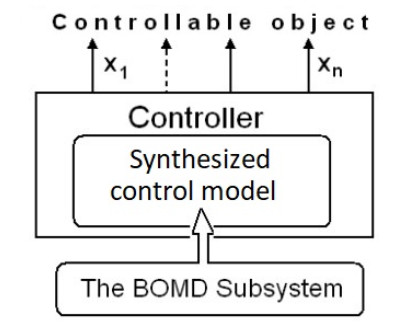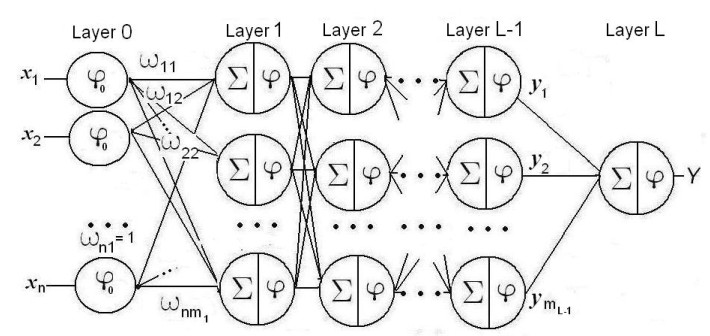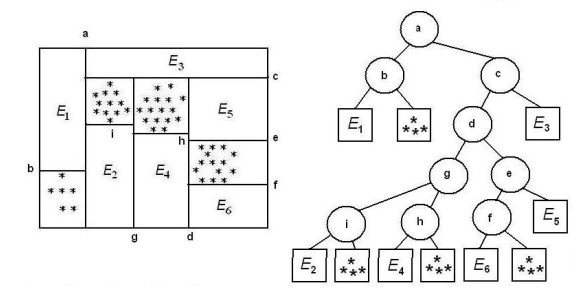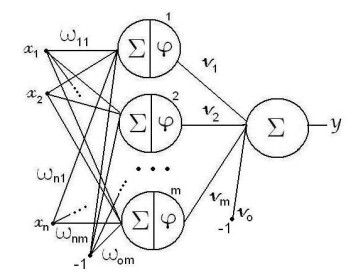This article aims to develop mathematical methods and algorithms that automatically build nonlinear models of planning and management of economic objects based on the use of empirical samples (observations). We call the relevant new information technology "Building Optimization Models from Data (BOMD)". The offered technology BOMD allows to obtain an objective control models that reflect the real economic processes. This is its main advantage over commonly employed subjective approach to management. To solve the problems posed in the article, the methods of artificial intelligence were used, in particular, the training of neural networks and construction of decision trees. If the learning sample contains simultaneously the values of the objective function and the values of characteristic function of constraints, it is proposed to use an approach based on the training of two neural networks: NN1 - for the synthesis of the objective function and NN2 - for the synthesis of the approximating characteristic function of constraints (instead of a neural network NN2, a decision tree can be used). The solution of the problem presented by such synthesized neural model may end up finding, generally speaking, a local conditional extremum. To find the global extremum of the multiextremal neural objective function, a heuristic algorithm based on a preliminary classification of the search area by using the decision tree is developed. Presented in the paper approach to an extraction of conditionally optimization model from the data for the case when there is no information on the points not belonging to the set of admissible solutions is fundamentally novel. In this case, a heuristic algorithm for approximating the region of admissible solutions based on the allocation of regular (non-random) empty segments of the search area is developed.
Citation: Vladimir Donskoy. BOMD: Building Optimization Models from Data (Neural Networks based Approach)[J]. Quantitative Finance and Economics, 2019, 3(4): 608-623. doi: 10.3934/QFE.2019.4.608
Related Papers:
| [1] |
Yuheng Wang, Yongquan Zhou, Qifang Luo .
Parameter optimization of shared electric vehicle dispatching model using discrete Harris hawks optimization. Mathematical Biosciences and Engineering, 2022, 19(7): 7284-7313.
doi: 10.3934/mbe.2022344
|
| [2] |
Dandan Fan, Dawei Li, Fangzheng Cheng, Guanghua Fu .
Effects of congestion charging and subsidy policy on vehicle flow and revenue with user heterogeneity. Mathematical Biosciences and Engineering, 2023, 20(7): 12820-12842.
doi: 10.3934/mbe.2023572
|
| [3] |
Xiangyang Ren, Shuai Chen, Liyuan Ren .
Optimization of regional emergency supplies distribution vehicle route with dynamic real-time demand. Mathematical Biosciences and Engineering, 2023, 20(4): 7487-7518.
doi: 10.3934/mbe.2023324
|
| [4] |
Fulin Dang, Chunxue Wu, Yan Wu, Rui Li, Sheng Zhang, Huang Jiaying, Zhigang Liu .
Cost-based multi-parameter logistics routing path optimization algorithm. Mathematical Biosciences and Engineering, 2019, 16(6): 6975-6989.
doi: 10.3934/mbe.2019350
|
| [5] |
Peng Zheng, Jingwei Gao .
Damping force and energy recovery analysis of regenerative hydraulic electric suspension system under road excitation: modelling and numerical simulation. Mathematical Biosciences and Engineering, 2019, 16(6): 6298-6318.
doi: 10.3934/mbe.2019314
|
| [6] |
Hamid Mofidi .
New insights into the effects of small permanent charge on ionic flows: A higher order analysis. Mathematical Biosciences and Engineering, 2024, 21(5): 6042-6076.
doi: 10.3934/mbe.2024266
|
| [7] |
Smita Shandilya, Ivan Izonin, Shishir Kumar Shandilya, Krishna Kant Singh .
Mathematical modelling of bio-inspired frog leap optimization algorithm for transmission expansion planning. Mathematical Biosciences and Engineering, 2022, 19(7): 7232-7247.
doi: 10.3934/mbe.2022341
|
| [8] |
Jana Zatloukalova, Kay Raum .
High frequency ultrasound assesses transient changes in cartilage under osmotic loading. Mathematical Biosciences and Engineering, 2020, 17(5): 5190-5211.
doi: 10.3934/mbe.2020281
|
| [9] |
Xiangyang Ren, Xinxin Jiang, Liyuan Ren, Lu Meng .
A multi-center joint distribution optimization model considering carbon emissions and customer satisfaction. Mathematical Biosciences and Engineering, 2023, 20(1): 683-706.
doi: 10.3934/mbe.2023031
|
| [10] |
Massimo Fioranelli, O. Eze Aru, Maria Grazia Roccia, Aroonkumar Beesham, Dana Flavin .
A model for analyzing evolutions of neurons by using EEG waves. Mathematical Biosciences and Engineering, 2022, 19(12): 12936-12949.
doi: 10.3934/mbe.2022604
|
Abstract
This article aims to develop mathematical methods and algorithms that automatically build nonlinear models of planning and management of economic objects based on the use of empirical samples (observations). We call the relevant new information technology "Building Optimization Models from Data (BOMD)". The offered technology BOMD allows to obtain an objective control models that reflect the real economic processes. This is its main advantage over commonly employed subjective approach to management. To solve the problems posed in the article, the methods of artificial intelligence were used, in particular, the training of neural networks and construction of decision trees. If the learning sample contains simultaneously the values of the objective function and the values of characteristic function of constraints, it is proposed to use an approach based on the training of two neural networks: NN1 - for the synthesis of the objective function and NN2 - for the synthesis of the approximating characteristic function of constraints (instead of a neural network NN2, a decision tree can be used). The solution of the problem presented by such synthesized neural model may end up finding, generally speaking, a local conditional extremum. To find the global extremum of the multiextremal neural objective function, a heuristic algorithm based on a preliminary classification of the search area by using the decision tree is developed. Presented in the paper approach to an extraction of conditionally optimization model from the data for the case when there is no information on the points not belonging to the set of admissible solutions is fundamentally novel. In this case, a heuristic algorithm for approximating the region of admissible solutions based on the allocation of regular (non-random) empty segments of the search area is developed.
Creating this inaugural special issue on Engineering Applications of Artificial Intelligence (AI) is important due to the rapid technology advancement and the aim to reduce the manpower by incorporating Artificial Intelligence in various Industry 4.0 applications. As my research reflects the multi-disciplinarily of systems (consisting of mechanical, electrical, electronics, acoustical and marine engineering) from initial concepts to the modelling and AI simulation, creating graphical-user interface and their actual implementations and testing on sites. The special issue provides a good platform to share applied research results from different researchers around the world.
For example, the phase partition-based ensemble learning framework upon least squares supports vector regression (LSSVR) was used for soft sensor modeling to improve the prediction accuracy in chemical and biological processes. As a result, the robotic grasping based on improved Gaussian mixture model was also proposed using the virtual robot experimentation platform. The face image recognition algorithm based on two-dimensional (2D) Gabor wavelet transform and Local Binary Pattern (LBP) was presented. It provides a better classification performance in different scales and directions affected by illumination, gesture, expression, and other factor's variation. With more consciousness in cyber-security, the paper that used the Kalman filter-based attack detection model was proposed. The block withholding delay attack and the countermeasure were also proposed in a similar occasion. The well-known convolutional neural network (CNN) based approach was applied to detect the obstacle for the unmanned surface vehicle. Subsequently, an effective classifier based on the CNN and regularized extreme learning machine (ELM) was adopted to reduce the classification time in the training and testing.
In summary, this issue concluded with different engineering applications of AI. It is imperative that we continue to progress in our search for better engineering systems design and simulation using AI. The progress reported in this special issue suggests that achieving these aims is an attainable one. I hope that we can stay in contact and make this world a better place for a "deep" collaborative research.
References
|
[1]
|
Abiodun OI, Jantan A, Omolara AE, et al. (2018) State-of-the-art in artificial neural network applications: A survey. Heliyon 4: 1-7.
|
|
[2]
|
Antonova GM (2011) Application of Pattern Recognition Methods to Solve Optimization Problems Using Imitation Models. Pattern Recognit Image Anal 21: 113-116. doi: 10.1134/S1054661811020076

|
|
[3]
|
Barton D, Court D (2013) Three Keys to Building a Data-Driven Strategy. Available from:https://www.mckinsey.com/business-functions/digital-mckinsey/our-insights/three-keys-to-building-a-data-driven-strategy.
|
|
[4]
|
Boz O (2002) Converting A Trained Neural Network To a Decision Tree DecText - Decision Tree Extractor. ICMLA 2002: Las Vegas, Nevada, USA 4: 110-116.
|
|
[5]
|
Breiman L, Friedman JH, Olshen R, et al. (1984) Classification and Regression Trees, Chapman and Hal, New York, NY.
|
|
[6]
|
Corne D, Lones MA (2018) Evolutionary Algorithms, In: Marti R, Panos P, and Resende M. (eds) Handbook of Heuristics, Springer, Cham.
|
|
[7]
|
Donskoy VI (2018) A Synthesis of Pseudo-Boolean Empirical Models by Precedential Information. Bulletin of the South Ural State University, Series: Mathematical Modelling, Programming and Computer Software 11: 96-107.
|
|
[8]
|
Donskoy VI (2017) Extraction of Optimization Models from Data: a Decision Tree and Forest based Approach. Taurida J Comput Sci Theory Math 4: 59-86.
|
|
[9]
|
Donskoy VI (1993) Partially Defined Optimization Problems: An Approach to a Solution that is based on Pattern Recognition Theory. J Sov Math 65: 1664-1668. doi: 10.1007/BF01097516

|
|
[10]
|
Donskoy VI (2012) Synthesis of coordinated linear optimization models according to precedential information: an approach based on Kolmogorov complexity. Taurida J Comput Sci Theory Math 1:13-25.
|
|
[11]
|
El-Sawi AA, Hussein MA, Zaki EM, et al. (2014) An Introduction to Genetic Algorithms: A survey. A practical Issues. Int J Sci Eng Res 5: 252-262.
|
|
[12]
|
Eremin II, Mazurov VlD (1979) Unsteady processes of mathematical programming, Nauka, Moscow.
|
|
[13]
|
Haykin S (2008) Neural Networks and Learning Machines, Prentice Hall.
|
|
[14]
|
Hornik K, Stinchcombe M, White H (1990) Univrsal Approximation of an Unknown Mapping and Derivatives Using Multilayer Feedforward Networks. Newral Networks 3: 551-560. doi: 10.1016/0893-6080(90)90005-6

|
|
[15]
|
Kolmogorov AN (1991) Algorithm, information, complexity, Znanie, Moscow.
|
|
[16]
|
Loh WY (2014) Fifty Years of Classification and Regression Trees. Int Stat Rev 82: 329-348. doi: 10.1111/insr.12016

|
|
[17]
|
MathWorks (2017) Building Models from Data and Scientific Principles. Available from: https://www.mathworks.com/solutions/mathematical-modeling/building-models-data-scientificprinciples.html.
|
|
[18]
|
Mazurov VlD (1971) Application of Methods of Theory of Pattern Recognition in the Optimal Planning and Management. Proceeding of I-st all-Union Conference on Optimal Planning and National Economy Management. Moscow.
|
|
[19]
|
Malhotra R, Singh N, Singh Y (2011) Genetic Algorithms: Concepts, Design for Optimization of Process Controllers. Comput Inf Sci 4: 39-54.
|
|
[20]
|
Roh Y, Heo G, Whang SE (2019) A Survey on Data Collection for Machine Learning. ArXiv: 1811.03402v2(201 [cs.LG].
|
|
[21]
|
Zhang S, Zhang C, Yang Q (2003) Data Preparation for Data Mining. Appl Artif Intell 17: 375-381. doi: 10.1080/713827180

|



















 DownLoad:
DownLoad: